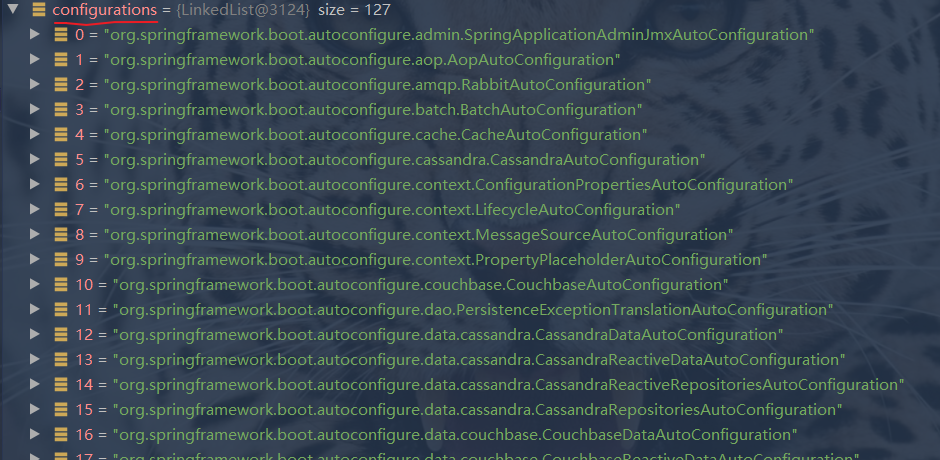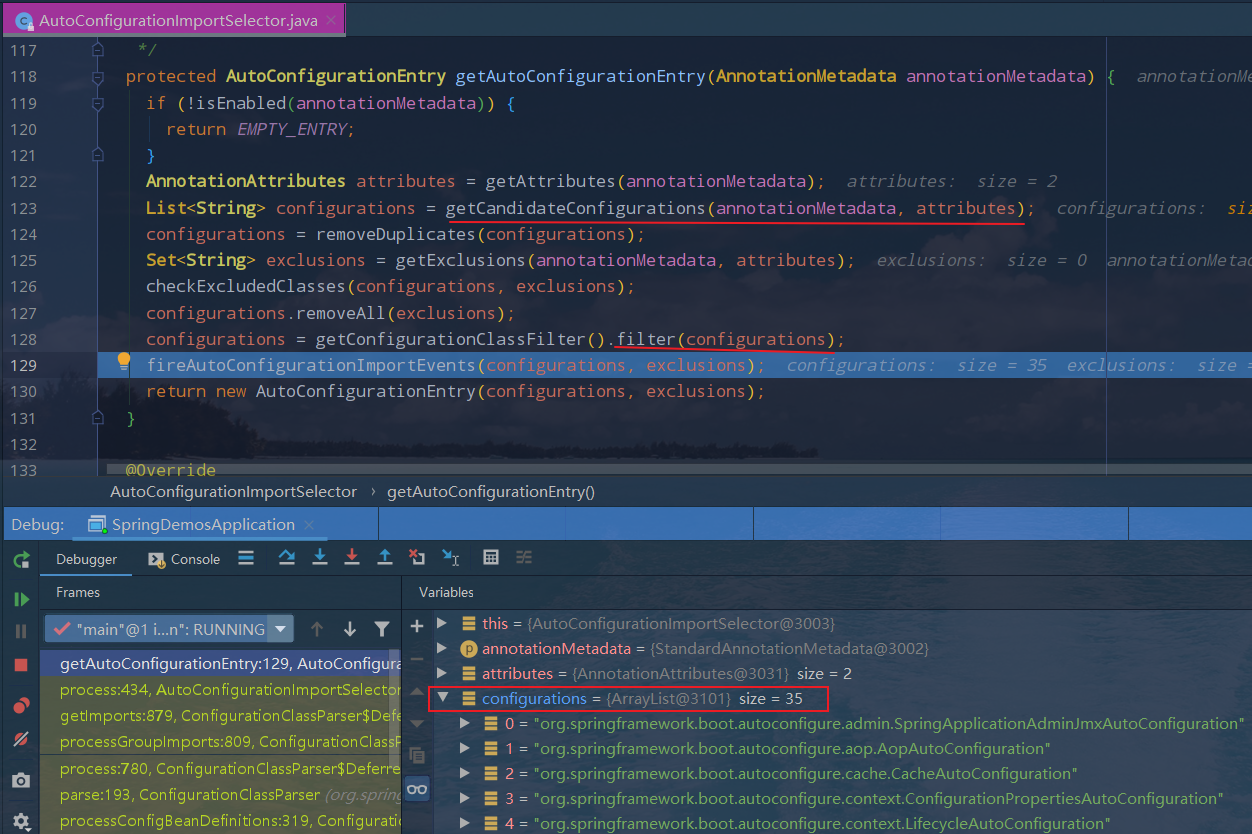SpringBoot启动原理(基于2.3.9.RELEASE版本)
版本
以下源码的 SpringBoot 版本:2.3.9.RELEASE。
总体上
分为两大步:
- 启动类上注解:@SpringBootApplication
- 启动类中的main方法:org.springframework.boot.SpringApplication#run(java.lang.Class<?>, java.lang.String...)
main方法上的注解:@SpringBootApplication
源码
三个注解核心注解:@SpringBootConfiguration,@EnableAutoConfiguration和@ComponentScan。
@Target(ElementType.TYPE)
@Retention(RetentionPolicy.RUNTIME)
@Documented
@Inherited
@SpringBootConfiguration
@EnableAutoConfiguration
@ComponentScan(excludeFilters = { @Filter(type = FilterType.CUSTOM, classes = TypeExcludeFilter.class),
@Filter(type = FilterType.CUSTOM, classes = AutoConfigurationExcludeFilter.class) })
public @interface SpringBootApplication {
@SpringBootConfiguration
根据Javadoc可知,该注解作用就是将当前的类作为一个JavaConfig,然后触发注解@EnableAutoConfiguration和@ComponentScan的处理,本质上与@Configuration注解没有区别。
@ComponentScan
扫描的 Spring 对应的组件,如 @Componet,@Repository。
我们可以通过 basePackages 等属性来细粒度的定制 @ComponentScan 自动扫描的范围,如果不指定,则默认Spring框架实现会从声明 @ComponentScan 所在类的package进行扫描,所以 SpringBoot 的启动类最好是放在根package下,我们自定义的类就放在对应的子package下,这样就可以不指定 basePackages。
@EnableAutoConfiguration
@EnableAutoConfiguration总结
@AutoConfigurationPackage
- 注册当前启动类的根 package
- 注册 org.springframework.boot.autoconfigure.AutoConfigurationPackages 的 BeanDefinition。
@Import(AutoConfigurationImportSelector.class)
- 可以看到实现了 DeferredImportSelector 接口,该接口继承自 ImportSelector,根据
Javadoc可知,多用于导入被 @Conditional 注解的Bean,之后会进行filter操作 - AutoConfigurationImportSelector.AutoConfigurationGroup#process 方法,
SpringBoot启动时会调用该方法,进行自动装配的处理,见SpringApplication#run(java.lang.String...)源码解析- SpringApplication#run(java.lang.String...)
- SpringApplication#refreshContext(即 Spring IOC 容器初始化的过程中)
- ConfigurationClassParser#parse
- AutoConfigurationImportSelector.AutoConfigurationGroup#process
- 通过SpringFactoriesLoader#loadFactoryNames获取应考虑的自动配置名称,例如来源于
spring-boot-autoconfigurejar包下的 META-INF/spring.factories 文件下的配置 - 通过 filter 过滤掉当前环境不需要自动装配的类,各种 @Conditional 不满足就被过滤掉
- 将需要自动装配的全路径类名注册到
SpringIOC容器,自此 SpringBoot 自动装配完成!
- 可以看到实现了 DeferredImportSelector 接口,该接口继承自 ImportSelector,根据
源码
@AutoConfigurationPackage
@Import(AutoConfigurationImportSelector.class)
public @interface EnableAutoConfiguration {
SpringBoot 自动装配的核心注解,在 Spring 框架中就提供了各种以@Enable开头的注解,例如: @EnableCircuitBreaker、@EnableScheduling等;
@EnableAutoConfiguration,借助@Import的支持,收集和注册特定场景相关的bean定义;
自动装配的类,通常是 @Configuration 类,通过 SpringFactoriesLoader 加载到 Spring 容器。
@AutoConfigurationPackage
注册当前启动类的根package;
注册 org.springframework.boot.autoconfigure.AutoConfigurationPackages 的BeanDefinition。
AutoConfigurationImportSelector
public class AutoConfigurationImportSelector implements DeferredImportSelector, BeanClassLoaderAware,
ResourceLoaderAware, BeanFactoryAware, EnvironmentAware, Ordered {
可以看到实现了 DeferredImportSelector 接口,该接口继承自ImportSelector,根据Javadoc可知,多用于导入被@Conditional注解的Bean
DeferredImportSelector接口中有个process方法,SpringBoot启动时会调用该方法,进行自动装配的处理,大体流程如下:
- SpringApplication#run(java.lang.String...)
- SpringApplication#refreshContext
- ConfigurationClassParser#parse
- AutoConfigurationImportSelector.AutoConfigurationGroup#process
AutoConfigurationImportSelector.AutoConfigurationGroup#process方法的源码:
调用了AutoConfigurationImportSelector#getAutoConfigurationEntry方法,获取需要自动装配类
public void process(AnnotationMetadata annotationMetadata, DeferredImportSelector deferredImportSelector) {
Assert.state(deferredImportSelector instanceof AutoConfigurationImportSelector,
() -> String.format("Only %s implementations are supported, got %s",
AutoConfigurationImportSelector.class.getSimpleName(),
deferredImportSelector.getClass().getName()));
// 获取需要自动装配类
AutoConfigurationEntry autoConfigurationEntry = ((AutoConfigurationImportSelector) deferredImportSelector)
.getAutoConfigurationEntry(annotationMetadata);
this.autoConfigurationEntries.add(autoConfigurationEntry);
for (String importClassName : autoConfigurationEntry.getConfigurations()) {
this.entries.putIfAbsent(importClassName, annotationMetadata);
}
}
AutoConfigurationImportSelector#getAutoConfigurationEntry大体流程如下:
通过SpringFactoriesLoader#loadFactoryNames获取应考虑的自动配置名称,例如来源于
spring-boot-autoconfigurejar包下的META-INF/spring.factories文件下的配置
通过filter过滤掉当前环境不需要自动装配的类,比如没有集成RabbitMQ,就不需要,或者有的条件@Conditional不满足也不需要自动装配
返回需要自动装配的全路径类名
源码如下:
protected AutoConfigurationEntry getAutoConfigurationEntry(AnnotationMetadata annotationMetadata) {
if (!isEnabled(annotationMetadata)) {
return EMPTY_ENTRY;
}
AnnotationAttributes attributes = getAttributes(annotationMetadata);
// 获取预先定义的应考虑的自动配置类名称
List<String> configurations = getCandidateConfigurations(annotationMetadata, attributes);
configurations = removeDuplicates(configurations);
Set<String> exclusions = getExclusions(annotationMetadata, attributes);
checkExcludedClasses(configurations, exclusions);
configurations.removeAll(exclusions);
// 通过filter过滤掉当前环境不需要自动装配的类,比如没有集成RabbitMQ,就不需要,或者有的条件@Conditional不满足也不需要自动装配
configurations = getConfigurationClassFilter().filter(configurations);
fireAutoConfigurationImportEvents(configurations, exclusions);
// 返回需要自动装配的全路径类名
return new AutoConfigurationEntry(configurations, exclusions);
}
AutoConfigurationImportSelector#getCandidateConfigurations源码如下:
protected List<String> getCandidateConfigurations(AnnotationMetadata metadata, AnnotationAttributes attributes) {
List<String> configurations = SpringFactoriesLoader.loadFactoryNames(getSpringFactoriesLoaderFactoryClass(),
getBeanClassLoader());
Assert.notEmpty(configurations, "No auto configuration classes found in META-INF/spring.factories. If you "
+ "are using a custom packaging, make sure that file is correct.");
return configurations;
}
通过SpringFactoriesLoader#loadFactoryNames获取应考虑的自动配置名称,通过META-INF/spring.factories下的配置,例如:

spring-boot-autoconfigure jar包下的
spring.factories文件:
执行完
configurations = getConfigurationClassFilter().filter(configurations);之后,各种@Conditional不满足就被过滤掉,剩下35个了
可以通过如下方法进行验证,结果没有
RabbitAutoConfiguration相关的Bean,抛出异常NoSuchBeanDefinitionException@SpringBootApplication
public class SpringDemosApplication implements ApplicationContextAware {
private static ApplicationContext applicationContext; public static void main(String[] args) {
SpringApplication.run(SpringDemosApplication.class, args);
System.out.println(applicationContext.getBean(AopAutoConfiguration.class));
System.out.println(applicationContext.getBean(RabbitAutoConfiguration.class));
} @Override
public void setApplicationContext(ApplicationContext applicationContext) throws BeansException {
SpringDemosApplication.applicationContext = applicationContext;
}
}
main方法
例子
main方法里调用org.springframework.boot.SpringApplication#run(java.lang.Class<?>, java.lang.String...)方法
@SpringBootApplication
public class SpringDemosApplication {
public static void main(String[] args) {
SpringApplication.run(SpringDemosApplication.class, args);
}
}
SpringApplication#run
调用另外一个同名的重载方法run
public static ConfigurableApplicationContext run(Class<?> primarySource, String... args) {
return run(new Class<?>[] { primarySource }, args);
}
实例化SpringApplication对象
- 首先会实例化SpringApplication一个对象
- 在构造方法里初始化一些属性,比如webApplicationType,比如"SERVLET",初始化一些listeners
public static ConfigurableApplicationContext run(Class<?>[] primarySources, String[] args) {
return new SpringApplication(primarySources).run(args);
}
public SpringApplication(ResourceLoader resourceLoader, Class<?>... primarySources) {
this.resourceLoader = resourceLoader;
Assert.notNull(primarySources, "PrimarySources must not be null");
this.primarySources = new LinkedHashSet<>(Arrays.asList(primarySources));
// 初始化webApplicationType,比如"SERVLET"
this.webApplicationType = WebApplicationType.deduceFromClasspath();
setInitializers((Collection) getSpringFactoriesInstances(ApplicationContextInitializer.class));
// 初始化一些listeners
setListeners((Collection) getSpringFactoriesInstances(ApplicationListener.class));
this.mainApplicationClass = deduceMainApplicationClass();
}
SpringApplication#run(java.lang.String...)源码解析
经典的观察者模式,只要你把事件广播的顺序理解了,那整个流程就很容易串起来了:
- 创建一个StopWatch实例,用来记录SpringBoot的启动时间
- 通过SpringFactoriesLoader加载listeners:比如EventPublishingRunListener
- 发布SprintBoot开始启动事件(EventPublishingRunListener#starting())
- 创建和配置environment(environmentPrepared())
- 打印SpringBoot的banner和版本
- 创建对应的ApplicationContext:Web类型,Reactive类型,普通的类型(非Web)
- prepareContext
- 准备ApplicationContext,Initializers设置到ApplicationContext(contextPrepared())
- 打印启动日志,打印profile信息(如dev, test, prod)
- 最终会调用到AbstractApplicationContext#refresh方法,实际上就是Spring IOC容器的创建过程,并且会进行自动装配的操作,以及发布ApplicationContext已经refresh事件,标志着ApplicationContext初始化完成(contextLoaded())
- afterRefresh hook方法
- stopWatch停止计时,日志打印总共启动的时间
- 发布SpringBoot程序已启动事件(started())
- 调用ApplicationRunner和CommandLineRunner
- 最后发布就绪事件ApplicationReadyEvent,标志着SpringBoot可以处理就收的请求了(running())
public ConfigurableApplicationContext run(String... args) {
// 创建一个StopWatch实例,用来记录SpringBoot的启动时间
StopWatch stopWatch = new StopWatch();
stopWatch.start();
ConfigurableApplicationContext context = null;
Collection<SpringBootExceptionReporter> exceptionReporters = new ArrayList<>();
configureHeadlessProperty();
// 通过SpringFactoriesLoader加载listeners:比如EventPublishingRunListener
SpringApplicationRunListeners listeners = getRunListeners(args);
// 发布SprintBoot启动事件:ApplicationStartingEvent
listeners.starting();
try {
ApplicationArguments applicationArguments = new DefaultApplicationArguments(args);
// 创建和配置environment,发布事件:SpringApplicationRunListeners#environmentPrepared
ConfigurableEnvironment environment = prepareEnvironment(listeners, applicationArguments);
configureIgnoreBeanInfo(environment);
// 打印SpringBoot的banner和版本
Banner printedBanner = printBanner(environment);
// 创建对应的ApplicationContext:Web类型,Reactive类型,普通的类型(非Web)
context = createApplicationContext();
exceptionReporters = getSpringFactoriesInstances(SpringBootExceptionReporter.class,
new Class[] { ConfigurableApplicationContext.class }, context);
// 准备ApplicationContext,Initializers设置到ApplicationContext后发布事件:ApplicationContextInitializedEvent
// 打印启动日志,打印profile信息(如dev, test, prod)
// 调用EventPublishingRunListener发布ApplicationContext加载完毕事件:ApplicationPreparedEvent
prepareContext(context, environment, listeners, applicationArguments, printedBanner);
// 最终会调用到AbstractApplicationContext#refresh方法,实际上就是Spring IOC容器的创建过程,并且会进行自动装配的操作
// 以及发布ApplicationContext已经refresh事件,标志着ApplicationContext初始化完成
refreshContext(context);
// hook方法
afterRefresh(context, applicationArguments);
// stopWatch停止计时,日志打印总共启动的时间
stopWatch.stop();
if (this.logStartupInfo) {
new StartupInfoLogger(this.mainApplicationClass).logStarted(getApplicationLog(), stopWatch);
}
// 发布SpringBoot程序已启动事件ApplicationStartedEvent
listeners.started(context);
// 调用ApplicationRunner和CommandLineRunner
callRunners(context, applicationArguments);
}
catch (Throwable ex) {
handleRunFailure(context, ex, exceptionReporters, listeners);
throw new IllegalStateException(ex);
}
try {
// 最后发布就绪事件ApplicationReadyEvent,标志着SpringBoot可以处理就收的请求了
listeners.running(context);
}
catch (Throwable ex) {
handleRunFailure(context, ex, exceptionReporters, null);
throw new IllegalStateException(ex);
}
return context;
}
SpringBoot启动事件
SpringApplicationRunListeners的唯一实现是EventPublishingRunListener;
整个SpringBoot的启动,流程就是各种事件的发布,调用EventPublishingRunListener中的方法。
只要明白了EventPublishingRunListener中事件发布的流程,也就明白了SpringBoot启动的大体流程
EventPublishingRunListener
方法说明如下:
public class EventPublishingRunListener implements SpringApplicationRunListener, Ordered {
private final SpringApplication application;
private final String[] args;
private final SimpleApplicationEventMulticaster initialMulticaster;
public EventPublishingRunListener(SpringApplication application, String[] args) {
this.application = application;
this.args = args;
this.initialMulticaster = new SimpleApplicationEventMulticaster();
for (ApplicationListener<?> listener : application.getListeners()) {
this.initialMulticaster.addApplicationListener(listener);
}
}
@Override
public int getOrder() {
return 0;
}
// SpringBoot启动事件
@Override
public void starting() {
this.initialMulticaster.multicastEvent(new ApplicationStartingEvent(this.application, this.args));
}
// 创建和配置环境
@Override
public void environmentPrepared(ConfigurableEnvironment environment) {
this.initialMulticaster
.multicastEvent(new ApplicationEnvironmentPreparedEvent(this.application, this.args, environment));
}
// 准备ApplicationContext
@Override
public void contextPrepared(ConfigurableApplicationContext context) {
this.initialMulticaster
.multicastEvent(new ApplicationContextInitializedEvent(this.application, this.args, context));
}
// 发布ApplicationContext已经refresh事件,标志着ApplicationContext初始化完成
@Override
public void contextLoaded(ConfigurableApplicationContext context) {
for (ApplicationListener<?> listener : this.application.getListeners()) {
if (listener instanceof ApplicationContextAware) {
((ApplicationContextAware) listener).setApplicationContext(context);
}
context.addApplicationListener(listener);
}
this.initialMulticaster.multicastEvent(new ApplicationPreparedEvent(this.application, this.args, context));
}
// SpringBoot已启动事件
@Override
public void started(ConfigurableApplicationContext context) {
context.publishEvent(new ApplicationStartedEvent(this.application, this.args, context));
AvailabilityChangeEvent.publish(context, LivenessState.CORRECT);
}
// "SpringBoot现在可以处理接受的请求"事件
@Override
public void running(ConfigurableApplicationContext context) {
context.publishEvent(new ApplicationReadyEvent(this.application, this.args, context));
AvailabilityChangeEvent.publish(context, ReadinessState.ACCEPTING_TRAFFIC);
}
@Override
public void failed(ConfigurableApplicationContext context, Throwable exception) {
ApplicationFailedEvent event = new ApplicationFailedEvent(this.application, this.args, context, exception);
if (context != null && context.isActive()) {
// Listeners have been registered to the application context so we should
// use it at this point if we can
context.publishEvent(event);
}
else {
// An inactive context may not have a multicaster so we use our multicaster to
// call all of the context's listeners instead
if (context instanceof AbstractApplicationContext) {
for (ApplicationListener<?> listener : ((AbstractApplicationContext) context)
.getApplicationListeners()) {
this.initialMulticaster.addApplicationListener(listener);
}
}
this.initialMulticaster.setErrorHandler(new LoggingErrorHandler());
this.initialMulticaster.multicastEvent(event);
}
}
private static class LoggingErrorHandler implements ErrorHandler {
private static final Log logger = LogFactory.getLog(EventPublishingRunListener.class);
@Override
public void handleError(Throwable throwable) {
logger.warn("Error calling ApplicationEventListener", throwable);
}
}
}
SpringIOC 容器初始化过程
由于现在大都是用SpringBoot开发,所以呢,Spring IOC 初始化的源码,就是AnnotationConfigApplicationContext中的源码,IOC的初始化就是该类实例创建的过程。
创建的过程(AnnotationConfigApplicationContext的构造方法),由于debug过这个源码,我个人把它分为两大步(暂时我先写出我的总结,后续看是否有时间能写一篇关于debug的过程):
- 给我们的Bean,创建与之对应的BeanDefinition,然后把他们放入ConcurrentHashMap(key:beanName和value:beanDefinition)中;BeanDefinition实际上包括一些Bean的信息,比如BeanName, Scope, 是否被@Primary注解修饰,是否是@Lazy,以及@Description等注解
- refresh()方法: 创建IOC需要的资源
- 初始化BeanFactory, set一些属性,如BeanClassLoader,systemEnvironment
- 如果是SpringBoot程序,会调用方法进行自动装配:AutoConfigurationImportSelector.AutoConfigurationGroup#process,见:@EnableAutoConfiguration的总结
- 注册MessageSource,国际化相关的资源,到ApplicationContext
- 注册ApplicationListener到ApplicationContext
- 实例化化lazy-init的Bean
- 最后,publish相关的事件,ApplicationContext 就初始化完成,整个IOC容器初始化完成(IOC容器的本质就是初始化BeanFactory和ApplicationContext),就可以从IOC容器中获取Bean自动注入了
SpringBoot启动原理(基于2.3.9.RELEASE版本)的更多相关文章
- SpringBoot启动原理及相关流程
一.springboot启动原理及相关流程概览 springboot是基于spring的新型的轻量级框架,最厉害的地方当属自动配置.那我们就可以根据启动流程和相关原理来看看,如何实现传奇的自动配置 二 ...
- SpringBoot启动原理
SpringBoot启动原理 我们开发任何一个Spring Boot项目,都会用到如下的启动类: @SpringBootApplication public class Application { p ...
- 深度好文,springboot启动原理详细分析
我们开发任何一个Spring Boot项目,都会用到如下的启动类 1 @SpringBootApplication 2 public class Application { 3 public stat ...
- springboot启动原理解析
springboot核心原理: 1.基于springmvc无配置文件完全注解化 + 内置web容器实现springboot框架.main函数方式的启动 2.通过maven快速整合第三方框架 sprin ...
- SpringBoot启动原理分析
用了差不多两年的SpringBoot了,可以说对SpringBoot已经很熟了,但是仔细一想SpringBoot的启动流程,还是让自己有点懵逼,不得不说是自己工作和学习的失误,所以以此文对Spring ...
- SpringBoot启动原理详解
SpringBoot和Spring相比,有着不少优势,比如自动配置,jar直接运行等等.那么SpringBoot到底是怎么启动的呢? 下面是SpringBoot启动的入口: @SpringBootAp ...
- 带着萌新看springboot源码11(springboot启动原理 源码上)
通过前面这么多讲解,springboot原理应该也大概有个轮廓了,一些基本的配置,从客户端url到controller(配置一些要用的组件,servlet三大组件,处理器映射器,拦截器,视图解析器这些 ...
- [转]springboot启动原理
参考文章:https://www.jianshu.com/p/ef6f0c0de38f
- SpringBoot之旅第六篇-启动原理及自定义starter
一.引言 SpringBoot的一大优势就是Starter,由于SpringBoot有很多开箱即用的Starter依赖,使得我们开发变得简单,我们不需要过多的关注框架的配置. 在日常开发中,我们也会自 ...
- SpringBoot启动流程及其原理
Spring Boot.Spring MVC 和 Spring 有什么区别? 分别描述各自的特征: Spring 框架就像一个家族,有众多衍生产品例如 boot.security.jpa等等:但他们的 ...
随机推荐
- API测试基础之http协议
http简介: http(超文本传输协议)是一个简单的请求-响应协议,它通常运行在TCP(传输控制协议)之上.它指定了客户端可能发送给服务器什么样的消息以及得到什么样的响应.请求和响应消息的头以ASC ...
- Axure在线教育考试原型图在线网课教育交互模板rp源文件
Axure在线教育考试原型图在线网课教育交互模板rp源文件 Axure在线教育原型图在线网课教育交互模板rp源文件是一款原创的儿童教育类的APP模板,使用axure rp软件制作.app中包含大约40 ...
- Linux内核中断irq.h头文件找不到的问题
头文件 在vscode中,进行tasklet和work中断实验的时候,对于包含的头文件如下两个一直爆红: #include <linux/irq.h> #include <linux ...
- vue3 基础-表单元素双向绑定
通常是在 form 表单相关的场景中会用到双向绑定相关, 核心是 v-model 的应用. input 输入框 <!DOCTYPE html> <html lang="en ...
- ASP.NET Core中对开放泛型(Open Generic)的依赖注入
public interface IRepository<T> { void Add(T entity); List<T> Get(); } public class Repo ...
- AtCoder Beginner Contest 370 补题记录
A - Raise Both Hands 题意: 给出Snuke举的左右手情况,如果只举左手,输出Yes,如果只举右手,输出No,否则输出Invalid 思路: 举左手:(l == 1 &&a ...
- 我的Vue之旅(2)
2020-10-22 仿照教程动手搞了一个Vue的组件化构建应用的Demo, 嗯,对,就是仿照,我一点都不觉得可耻.关于Vue组件化给我的感觉就是自己写一些 类似于HTML中的 h1, a, p这样的 ...
- PVE折腾笔记 (3) 在原QNAP使用的硬盘上创建ZFS
前言 在经过一番研究后,我决定使用ZFS作为俩机械硬盘的文件系统,本来也可以和QNAP一样直接ext4的,但ZFS比较安全,有自愈功能,可以处理比特位翻转的问题,总之就是好用. 如果追求灵活性可以使用 ...
- 直播预约丨《袋鼠云大数据实操指南》No.1:从理论到实践,离线开发全流程解析
近年来,新质生产力.数据要素及数据资产入表等新兴概念犹如一股强劲的浪潮,持续冲击并革新着企业数字化转型的观念视野,昭示着一个以数据为核心驱动力的新时代正稳步启幕. 面对这些引领经济转型的新兴概念,为了 ...
- OceanBase向量检索在货拉拉的探索和实践
作者:陈铨,货拉拉大数据技术与产品部高级大数据工程师 首先为大家推荐这个 OceanBase 开源负责人老纪的公众号 "老纪的技术唠嗑局",会持续更新和 #数据库.#AI.#技术架 ...
